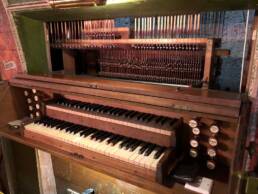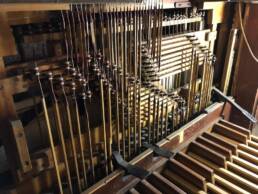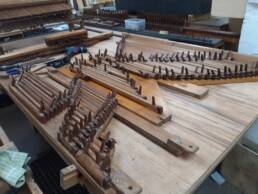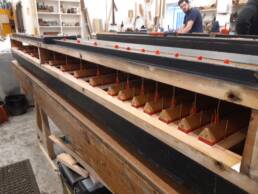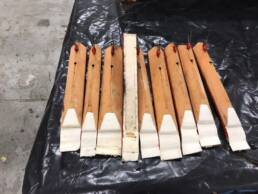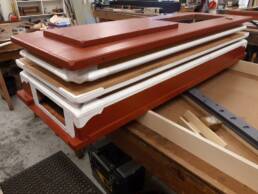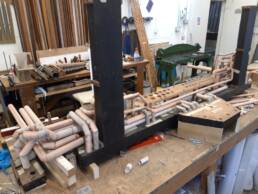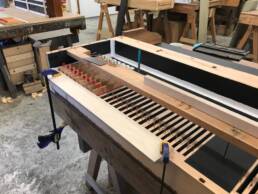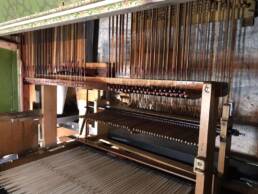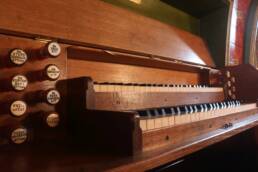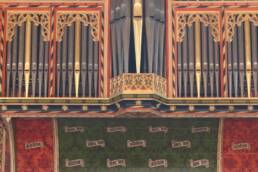Organ
The organ was installed by RW Walker & Sons in 1872 and is sited across the west wall of the nave, in a polychrome case designed by Gilbert Scott junior and richly decorated by Charles Eamer Kempe. It replaced an earlier Samuel Green organ installed 86 years earlier in 1786, which still survives and can be seen at Croft Castle in north Herefordshire.
Between its installation in 1872 and 1972 there is no record of any substantive renovation work being carried out on the organ. In 1972 however it was altered very significantly by Anthony Wordsley of Clun. Nicholson’s in their restoration report (mentioned below) comment in some detail on this restoration saying:
“In the fashion of the day, when Victorian tonal palletes were considered dull in comparison to the brighter tonalities that were then in vogue. The following stops were removed from the organ: Claribel Flute 8’, Gamba 8’, Flute 4’ (Gt), Open Diapason 8’ and Oboe 8’, all to be replaced by the exciting new sound world of a Stopped Diapason 8’, Nazard 22/3’, Tierce 13/5’, Quartane II and Fagotto 8’. All the metal conveyancing in the organ was removed and replaced with flexible cardboard hose.
Sadly, the work proved to be unfortunate in both its intention and execution, such that Nicholson & Co. was requested to step in and undertake work in 1978, having been given the brief to do the minimum necessary to return the organ to reliable playing condition, and the minimum necessary to address the unpleasant harshness of the organ’s new sound … To address the disappointment of the 1972 tonal work, all of the 1972 pipework (none of which had been made new for that work) was replaced in 1978 with good-quality material of appropriate period and quality from Nicholson & Co. second-hand stock. The 1978 Nicholson & Co. tonal scheme was in spirit a reversal of the 1972 Wordsell changes, but was not commissioned as an exact return to the 1872/3 specification”.
In 2017, a report was commissioned on the condition of the RW Walker organ by the Moccas Parochial Church Council (PCC). Various organs companies and specialist organ contractors were asked to visit the church and undertake an appraisal of the organ’s condition. These appraisals showed that significant restoration works were required. A copy of the appraisal carried out by Nicholsons outlining the work that was required can be viewed by clicking on the link below.
Moccas Church Information Sheet V – RW Walker Organ – Appraisal Report (author Nicholsons)
Nicholsons following their inspection in 2017 stated that the organ was “…now in need of a comprehensive restoration to return it to pristine condition along with a further tonal recovery work to reinforce the ideals of the original tonal scheme…” and described the condition as follows:
“The organ was in regular weekly use, but was becoming increasingly troublesome mechanically. Much wear in the mechanical action—not given serious attention since the organ’s construction—had made the mechanism noisy. Wind leakage was considerable, and the electric blower could not meet the demands of even medium registrations. The pipework was grubby but in fairly good physical condition.
The interior of the organ was a sad mixture of original Walker material, and inappropriate components introduced in 1972 – flexible cardboard hose, plywood rackboards, etc. The expression pedal had been disconnected. Some runnings were evident due in particular to the condition of the grid coverings on the soundboards.
The case and console woodwork remained structurally sound but were in poor aesthetic condition. The appearance remained impressive from a distance, but closer inspection revealed much grime and the cumulative effect of many smaller bruises, dents sustained over a long life”.
Following the recommendations outlined in this appraisal the PCC took the decision to start a funding raising campaign to raise the significant funds required to instruct Nicholsons to carry out the required works. Due to the invaluable support of the Heritage Lottery Fund and the generosity of many private donors and charities (mentioned below) over £110,000 was raised and work on the restoration commenced in January 2020.
The work involved the complete dismantling of the organ and its removal to Nicholsons workshop in Malvern where restoration work was carried out between January and October 2020.
Dismantling
The work was extensive and included:
- the manufacture and fitting of a new backfall,
- the restoration of the rollerboards,
- the restoration of the console chassis,
- the rubbing down and repainting of the metal roller arms,
- the restoration of existing trackers (as well as the fitting of new ones),
- the restoration of the drawstop action,
- the restoration of the swell soundboards,
- the carrying out of repairs to splits in the Bourbon chests,
- the restoration and releathering of the small reservoir,
- the manufacture and fitting of new conveyances,
- the fitting of new tuning rolls,
- the gilding of the façade pipes,
- the restoration of the pedalboards,
- the restoration of the great soundboard,
- the cleaning of all the organ pipes,
- the fitting of a new blower cabinet,
- the fitting of a new metal wind trunk,
- the fitting of a new electric blower,
- the fitting of new tuning sliders and the replacement of the Viole pipe in the Swell Organ with a new Horn Diapason 8’ pipe.
Restoration of Console & Mechanical Action
Restoration of Pedal Organ Chests
Restoration of Wind System
Restoration of Sound Boards
The following short video from Nicholsons shows the Horn Diapason for the Swell organ being restored and played in their Malvern workshops.
For more details on the restoration works and photographs please read the restoration report produced by Nicholsons which can be viewed by clicking on the link below.
Moccas Church Information Sheet II – RW Walker Organ – Restoration Report 2020 (author Nicholsons)
Installation
The aim of this once in a generation restoration project was aptly summarised in the Nicholsons report as follows:
“The foremost aim of the present work has been to return the organ to reliable playing condition for generations to come, and to put right those elements of the 1972 work that sat uncomfortably with the rest of the instrument but which funding did not permit to be addressed in 1978. The opportunity has also been taken to return the tonal scheme to something closer to the original scheme, though again not precisely; our hope is that the instrument, which contains much non-original pipework from various sources, now reflects the character and spirit, if not the letter, of its original conception”.
If you would like to see more photos of the restoration please click here.
Completed Restoration
We thank the Heritage Lottery Fund, the Prince of Wales Charitable Trust, Church Care, the All Churches Trust, Lasletts Trust and all our other extremely generous private donors for making this work possible.
